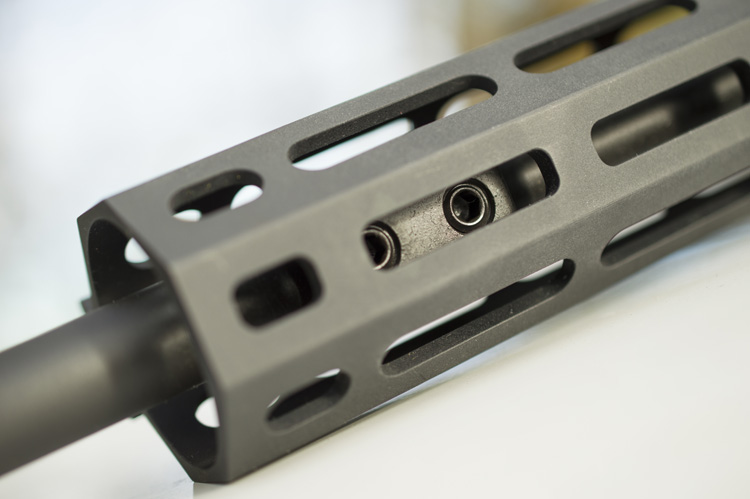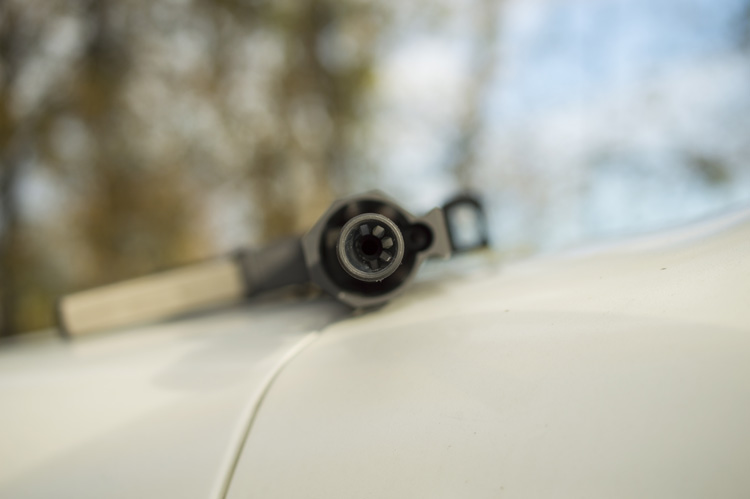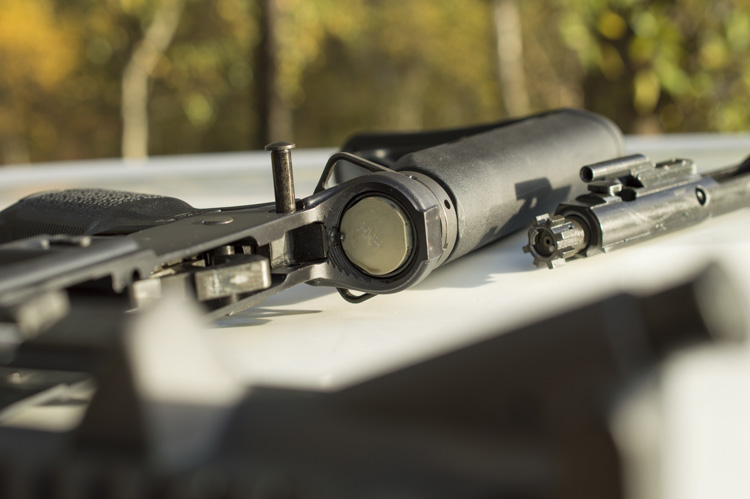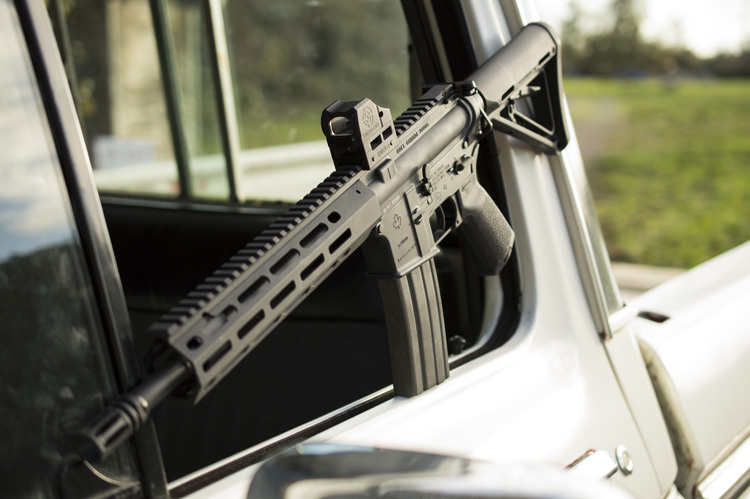
The IUR is dead. Long live the IUR. Standing for "Integrated Upper Receiver," Colt Canada's take on the monolithic AR-15 upper receiver has seen more than a few iterations, but the latest version changes everything. Trading old-school rails for modern M-Lok slots, improving serviceability dramatically, and putting the entire thing on a substantial diet, the new Colt Canada Modular Railed Rifle (Colt Canada MRR) signals the death knell for the venerable rifle we've known as the last-gen IUR.
By far most striking aspect of the new Colt Canada MRR is the rifle's weight. Although there are numerous small updates delineating the MRR from the previous generations of Colt Canada's Integrated Upper Receiver platform, the main focus during this new rifle's design has obviously been to reduce the overall weight of the rifle, and it has worked.
While many may think it's the replacement of the quad rails with M-Lok slots that's generated the majority of the weight savings, the reality is that most of the weight has been pared off what's inside that svelte new handguard: The barrel.
Where previous IUR rifles featured a very heavy profile barrel from the chamber to the gas block, and then reverted to a medium profile thereafter, the new Colt Canada MRR is stepped down in every dimension. The barrel's only as thick as it needs to be to allow the gas block to index properly (more on that later), and it's cut down even further after the gas block. Interestingly, the longer 16" and 18.6" models both feature the same diameter from chamber to gas block, but maintain a heavier diameter between the gas block and the muzzle. As a result, each variant of MRR is approximately half a pound lighter than its IUR sibling; our test 11.6" Colt Canada MRR tipped the scales at 6.4 pounds unloaded, while an identically sized IUR weighs in at 6.99 pounds.

In our experiences, we found all the MRR's capable of producing sub-MOA groups with the right ammunition, and all will typically produce just over 1 MOA groups with good factory ammo. In fact, throughout Colt Canada's own testing (which involves a great many more rounds than any civilian could ever afford) an 11.6" carbine, like the one featured here, produced the same 1.2 MOA group with 62-grain C77 ball (Canada's equivalent to SS109 and M855), Federal's 69-grain .223 load using Sierra MatchKing BTHP bullets, and Hornady's 75-grain 5.56 Match BTHP round. We found similar performance in our own testing.
The next big revision within the Colt Canada MRR is, again, found inside the handguard. One of the most significant bugaboos with Colt Canada's IUR has been the issue of maintenance: Monolithic upper receivers do not lend themselves well to standard AR-15 barrel nuts and wrenches.
On the first IURs, two doors were installed on either side of the barrel nut to allow for access. On subsequent models, that particular issue was solved through the creation of barrel wrenches that slip down the length of the handguard, and the doors were ditched. The next problem became how to install the gas block. Until now, this was accomplished by feeding the gas block retaining pins through clearance holes in the handguard; a process that was a total pain in the ass.

All three barrel lengths use the same carbine-length gas system, meaning that the gas port is just 7" from the chamber. On longer-barrelled rifles such as the 18" DMR, this would normally result in too much gas being directed back into the action; a phenomenon known as over-gassing. This can increase both recoil and wear. However, Colt Canada addressed the issue by tuning their gas port size and chamber specifications to ensure correct gas metering, and then confirmed their findings by verifying the bolt carrier velocity through high-speed video footage.

Of course, it's not the only system, and much has been made of Colt Canada's decision to opt for M-Lok over the comparable KeyMod system. When asked directly why M-Lok was selected, the answer from Colt Canada was simple: The Colt Canada MRR is designed to meet the requirements of the US Army's M4A1 Plus rifle program. And within those requirements, an enhanced handguard assembly is outlined, and the US Army prefers M-Lok.
The rest of the rifle, namely the back half of the upper receiver and the entire lower receiver, are standard Colt Canada mil-spec parts. The bolt carrier found inside the upper receiver is a factory Colt Canada assembly, and for those gun nerds that care about such things, it is indeed a full-auto bolt carrier.

As a result of this combination, the MRR features the heaviest reciprocating assembly available in a mil-spec (ie. not commercial) AR-15 pattern rifle; a combination chosen by Colt Canada's engineer's to help fine-tune the bolt carrier speeds and ensure 100% reliability.
Finally, below the rear takedown pin, you'll find the blight that all Colt Canada rifles are issued with: An Accu-Wedge. A rubber wedge designed to eliminate any play between the receivers, this incessant chunk of frustration does nothing but make a rifle harder to take down by putting constant strain on the rear takedown pin. Externally, the gun comes fitted with a six-position Magpul MOE stock and pistol grip. Although we've never complained with the standard Colt Canada stocks and A2-style grips, the more modern Magpul furniture suits the new MRR, and feels great.

Now, we've shot a lot of Colt Canada MRRs. We first tested them about a year ago at a military event in the USA where no cameras were allowed, and the security guards were checking car trunks. We've since shot those same pre-production samples numerous times with no failures, and have put over 1,200 rounds of mixed ammunition through our own 11.6" tester. In fact, probably no other rifle we've tested has accrued the round count this diminutive Colt Canada MRR has in such a short time.
Furthermore, it was also used to introduce a pair of journalists to the world of shooting, as well as countless fellow range users interested in shooting an AR-15 for the first time. It has never failed. Yeah, we've cleaned it occasionally, but it's never failed to do what it's supposed to regardless of the conditions.

We momentarily thought about putting a muzzle brake on it to see how much faster we could shoot it, but then remembered... we like our eardrums and few things sound as belligerent as muzzle braked, short-barreled AR-15s.

It's also worth noting that besides reliability, this new Colt Canada MRR feels much better. The lightened handguard doesn't only help accomplish that half-pound weight reduction, but the slender profile afforded by the M-Lok system really reduce its overall size.
The entire handguard is just over 2" tall and about 1-3/4" across left to right, so it's easy to wrap your whole hand around it, and that combined with the lighter weight gives the shooter a lot of authority over where that muzzle is pointing. That in turn creates confidence, and makes it a great rifle for those of smaller stature that might find a heavier rifle daunting.

But, it's pricey. And it doesn't come with sights, or ambi controls, which is disappointing, given the price point. Honestly, we thought it was a bit overpriced, at least until we started to actually spend some serious time behind one.
Then we realized what it is, and where the value lies. It's a rifle for the guy that doesn't want to tune, build, or otherwise dick around with his gun. Because you won't need to do anything to it besides stick an optic on it, buy an M-Lok sling swivel, and double your ammo budget. It's utterly reliable. It's superlatively well-made. And best of all, it's made right here in Canada, so we give it two enthusiastic thumbs up.